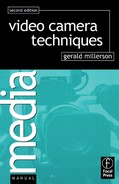In a well-balanced sequence, there are wider shots (long shots) showing the broad action and its location; and closer shots (close-ups, mid-shots) concentrating attention on particular features. Each type of shot has its part to play in persuading and holding the audience’s interest.
The most obvious method of adjusting shots is to change the position of your camera. For closer shots you simply move nearer; the subject itself appears larger and surroundings are gradually excluded. Moving further away for a longer shot, the subject now appears smaller, and you reveal more of the surroundings. You could shoot an entire production very successfully with the zoom lens left at around 25°. This straightforward approach does have its disadvantages however:
• To vary shot sizes you would have to continually move the camera. That can be time-consuming and tiring.
• When recording continuously, this can produce a lot of irrelevant material, that has to be edited out. If you stop recording while you move the camera, you may miss some of the action.
• Alternatively, you may be able to stop the action while moving the camera. But then it will be necessary to have the performer/talent repeat the end of previous action, to provide overlaps for editing.
• Frequent camera moves to vary the shot size can look very fidgety.
• When intercutting between several cameras shooting the same subject, there is always the danger that one camera will come into another’s shot.
Changing to a different focal length, does two fundamental things:
• It varies the apparent nearness, prominence, importance of the subject.
• It decides how much of the action and the surroundings your audience is aware of, and can see. Unless they have previous knowledge of what is going on (or can hear clues), they will not know what they are missing out of shot (e.g. an onlooking crowd).
Within the range of a 15:1 zoom lens, you can fill the screen with a wide overall view of a street (e.g. 50°) or a poster that was previously scarcely visible (e.g. 5°) – all without moving the camera. So clearly, you could avoid moving the camera altogether, simply by readjusting the lens to alter the shot size. Many people do just that! But as you will see, that can produce some very undesirable side-effects. Where possible, it is much more effective to move your camera around on a normal lens angle, only varying its focal length when there is some practical advantage.
Coverage changes
How much of the scene is covered by the lens (its angle of view) depends on its focal length, relative to the camera tube’s image size. As the len’s focal length is changed, its angle of view alters correspondingly. For example, if you use a lens of one-third the focal length, the angle of view becomes three times as wide. Three times as much of the scene is covered but subjects appear a third of their previous size in the shot.

